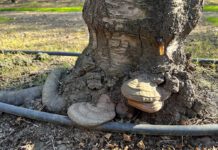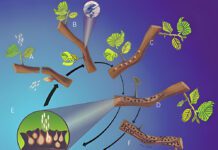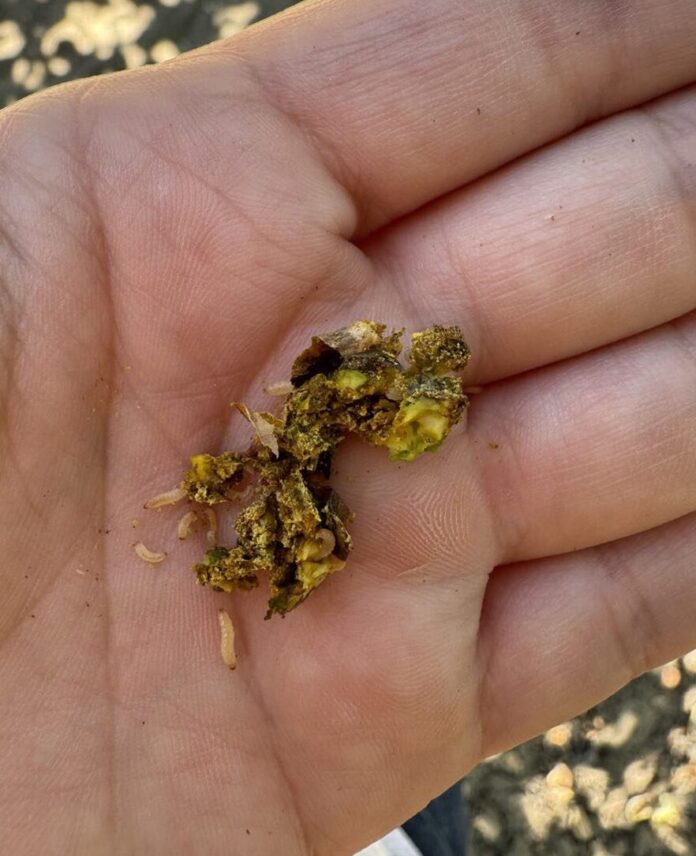
When PCA Justin Nay began finding fine, powdery frass in Peterson traps set to monitor navel orangeworm (NOW) activity in June, he suspected the invasive Carpophilus beetle was making inroads in pistachio orchards in Kern and Tulare counties.
Early split nuts are vulnerable to infestation by this species of beetle, and Nay said in early August that he expected beetles would also be found at hull slip, damaging kernels of split nuts.
“With early splits, we would crack them open and see adult beetles, larvae and sometimes both in the same nut,” he said. The powdery frass produced by the beetle may resemble ant feeding, but Nay said the frass is much finer. It is also distinguishable from NOW frass.
Carpophilus beetle (Carpophilus truncatus) was first reported in almond and pistachio last year in the Central Valley. Jhalendra Rijal, statewide UC IPM specialist, said this pest is capable of inflicting serious damage to almond and pistachio and could prove to be a worse pest than NOW in some years. Carpophilus beetle has been a serious insect pest in Australian almond orchards and has caused damage in tree nut crops in Italy and Argentina. Houston Wilson, entomology specialist at UC Riverside, in a recent grower notice, wrote that, in Australian almond production, 2% to 5% crop damage can be attributed to Carpophilus beetle. Damage levels can reach 30% to 40% in some years. The beetle is also known to spread fungi that can lead to aflatoxin production.
Infestations of Carpophilus beetles are common this year in the northern San Joaquin Valley almond orchards where they were observed last year, and Rijal said they are spreading.
The black adults are tiny at 2.5 millimeters in length. Adult females lay eggs (a lot of eggs, Rijal said) on hull split almond and pistachio. They can damage both early and regular and hull slip pistachio. The larva and adults feed directly on the kernels. Rijal noted both larvae and adults can be found inside kernels through late fall.
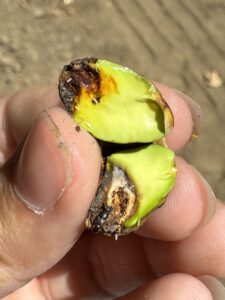
Egg Identification
Beetle eggs are tiny, white and oblong in shape. The larva is creamy white in color with a brown head and forked tail. Adults survive the winter in mummy nuts. Beginning spring, they lay eggs on those mummy nuts on the ground. Newly emerged adults move into split nuts to lay eggs. High temperatures, moisture and food sources can push new generations in as little as three weeks.
Presently, there are no commercial traps or lures for monitoring Carpophilus beetle populations. A Carpophilus beetle team including Rijal is testing pheromone lures. He said nut sampling at hull split, damage assessment at harvest and mummy nut sampling after harvest can help determine the infestation levels in an orchard. In almonds, the soft shell varieties seem to be more vulnerable to infestation.
Rijal said Carpophilus beetle and NOW may infest nuts separately or co-infest. Feeding damage by the larvae and adults may appear similar, but it is important to distinguish between the two, along with ant damage in almonds. Softer-shell almond varieties are most vulnerable to beetle infestation. Nay said in pistachio, it appears the beetles wait until the shell splits open and exposes the kernel.
Carpophilus beetle and larvae feed on the kernels, leaving the kernel skin mostly intact. They leave a fine, powdery frass with some webbing. They typically infest in large numbers, and more than 10 adults and larvae can be found feeding on a single kernel.
NOW damage leaves thicker frass and silky webbing with a darker brownish appearance. Only larvae are present, typically one to three per kernel.
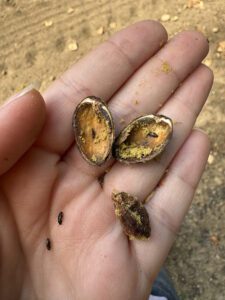
Overwinter in Mummy Nuts
Both pests overwinter in mummy nuts, with beetles tending to prefer ground mummies. This is where both Rijal and Nay stress orchard sanitation is the best control tactic at present. During the winter, most adult beetles are found in the ground mummies, Nay said, making orchard sanitation paramount if evidence of beetle infestation was found at harvest. Pistachio growers need to attain an almond standard of sanitation, with smoother orchard floors making it possible for more mummies to be gathered, Nay recommended. After the mummy shake, nuts should be swept, not blown, into windrows in the centers, away from shade and moisture. It would be ideal to grind the mummies to remove beetle overwintering sites, Nay said, but machinery to do that job isn’t currently available. Flail mowers can be used, he said, but they tend to kick nuts out of the windrows.
No commercial traps or lures to monitor Carpophilus beetles are available, but Rijal noted promising pheromone lures specific to C. truncatus that Australian colleagues developed are being tested. Because this pest is new to California, UCCE advisors are working on biological and chemical control strategies.
In Australia, focus is on an entomopathogenic fungi which can kill adult beetles. Chemical control with insecticides is limited due to challenges with spray coverage. Most of the beetle’s life cycle is spent protected inside nut shells and there is only a short window of opportunity for control.
In a UC webinar, David Madge of Agriculture Victoria noted that, in some years, almond growers in Australia are losing tens of millions of dollars due to beetle damage. Industry feedback on efficacy of pesticide applications is mixed given difficulties hitting the hull split target.
Orchard sanitation is the key to all control approaches, but Madge noted ground mummy removal can be difficult. In trials, the mummies were buried in trenches, but adults were emerging from 30 to 60 centimeters. Australian almond grower Ben Brown confirmed the burying trials failed to stop adults from emerging. Burning mummies did not work. Growers have also tried a spray application of the entomopathogenic fungi. A mechanical solution, the “Almond Terminator,” is being tested to finely grind mummies.
A true area-wide IPM approach will be needed to control beetle populations, Joshua Fielke of Almond Board of Australia said.
Proposals for control measures in California include study of seasonal phenology, temperature thresholds and degree-day guidelines similar to NOW. Researchers are also proposing to determine spring emergence and confirm beetle distribution in tree canopies. Pheromone lure and trap development and mass rearing for sterile insect technique are included in the 2024 research proposals.
Currently, Nay said he is monitoring flight activity and has used a pyrethroid with a hull split spray to knock down adult populations.
“It’s an interesting dynamic,” Nay said of the twin threat of NOW and C. truncatus vying for the same food resources. Both insects directly attack kernels, but the species that consumes more at a faster rate will win the competition.

Cecilia Parsons | Associate Editor
Cecilia Parsons has lived in the Central Valley community of Ducor since 1976, covering agriculture for numerous agricultural publications over the years. She has found and nurtured many wonderful and helpful contacts in the ag community, including the UCCE advisors, allowing for news coverage that focuses on the basics of food production.
She is always on the search for new ag topics that can help growers and processors in the San Joaquin Valley improve their bottom line.
In her free time, Cecilia rides her horse, Holly in ranch versatility shows and raises registered Shetland sheep which she exhibits at county and state fairs during the summer.








